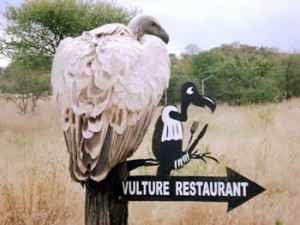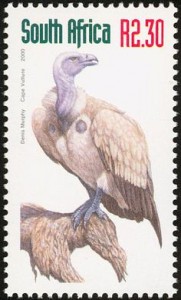Week 36 – 19 March 2017:
A Vulture in the Next Life
If I am to be reincarnated, I hope that I will not be brought back as a Cape Vulture. They must have great personalities, because they certainly don’t get dates on the basis of their looks. The scientific name of the Cape Vulture, Gyps coprotheres, is based on Greek words with imply that they hunt dung. They don’t hunt dung, of course, but rather scavenge carcasses of medium and large animals, which doesn’t seem like much of a step up. Even though they nest on cliffs, eggs and chicks are vulnerable to predation by eagles, crows, ravens and baboons. All in all, it sounds like a pretty tough life.
Considered to be endangered by the International Union for the Conservation of Nature, and with a rapidly declining population throughout southern Africa, a group of experts enumerated the forces working against the Cape Vulture. These included inadvertent poisoning of their food, inadequate availability of carrion during the chick-rearing phase, disturbance at their breeding colonies, habitat loss, persecution, electrocution, drowning, lead poisoning, and hunting because of a mistaken perception that eating them will have medicinal or psychological value.
Some experts see the provisioning of Cape Vultures with food at “vulture restaurants” as one of the keys to their survival. The goal is to direct birds away from uncontrolled sources of food, and provide them with predictable, poison-free nutrition. Do these restaurants serve their intended purpose? Studies of other vultures have generally reported a positive outcome. Does this also apply to the provisioning of Cape Vultures?
Dana Schabo and her colleagues recently reported on a twelve-year study of supplementary feeding at a breeding colony of Cape Vultures in KwaZulu-Natal Province in South Africa. Given that an adult pair and their single chick require about 230 kilograms of meat, and that the colony consists of forty-nine breeding pairs and about two dozen non-breeders… well, that quickly adds up to a lot of food. The vulture restaurant has been supplying Cape Vultures since 2001. On the menu are carcasses of cows, pigs and plains zebras, supplied by livestock farmers and a local conservation organization. Feedings varied, depending on the availability of carcasses.
The good news is that supplementary feeding during the nest building part of the year had a positive influence on the number of breeding adults. Schabo et al. felt that additional food permitted adults to enter the breeding season in better condition, allowing them to choose to breed, rather than waiting for conditions to improve. More food, more breeding. Curiously, providing extra food during the incubation and chick-rearing stages did not result in a higher probability of individual breeding success. It could be that not enough food was supplied to meet the needs of a colony full of growing chicks, particularly since the food supply was irregular. Alternatively, the vulture restaurant may have attracted potential predators of vulture eggs and chicks.
When I contacted her, Schabo provided me with further details of the work of the Cape Vulture team. These birds appear to play an important ecological role, but their “scavenging service is completely underappreciated and understudied.” One of the keys to the project was contact with a sugar cane farmer, Mike Neethling. Schabo described him as a passionate bird enthusiast who also happened to have a Cape Vulture breeding colony on his land. Since starting a vulture restaurant more than fifteen years ago, Neethling has made notes on every carcass set out as food, as well as breeding records for the vultures. “Mike is the hero of the story!” wrote Schabo. Because Cape Vultures cannot rip into a carcass by themselves, Neethling goes so far as to cut them open. Watching the resulting frenzy of feeding vultures must be a magnificent sight.
Local vulture enthusiast Andy Ruffle jointed the research team in 2014. He spends endless hours in a hide at the breeding colony, documenting the behaviour of these fascinating birds. Ruffle and Neethling take interested people to the breeding cliffs, detailing the ecological roll of the vultures, and explaining why it is important to protect them.
We will need additional details about the lives of Cape Vultures if we are to be sure of their long-term survival. Since 2012, the research team has been fitting individuals with satellite transmitters to track their movements. The primary focus is young birds because their mortality is so high after leaving the colony. The data is currently being analyzed, and should soon be ready for publication.
You can read more about the important work on these vultures at www.gyps-corotheres.net. Despite the supplemental feedings, I still don’t want to be reincarnated as a Cape Vulture.
Schabo, D. G., et al. 2016. Long-term data indicates that supplementary food enhances the number of breeding pairs in a Cape Vulture Gyps coprotheres colony. Bird Conservation International doi.org/10.1017/S0959270915000350.
Photo credits: Cape Volture perched on “vulture restuarant” sign – www.restafrica.org; Cape Vulture stamp from South Africa – www.pinterest.com



